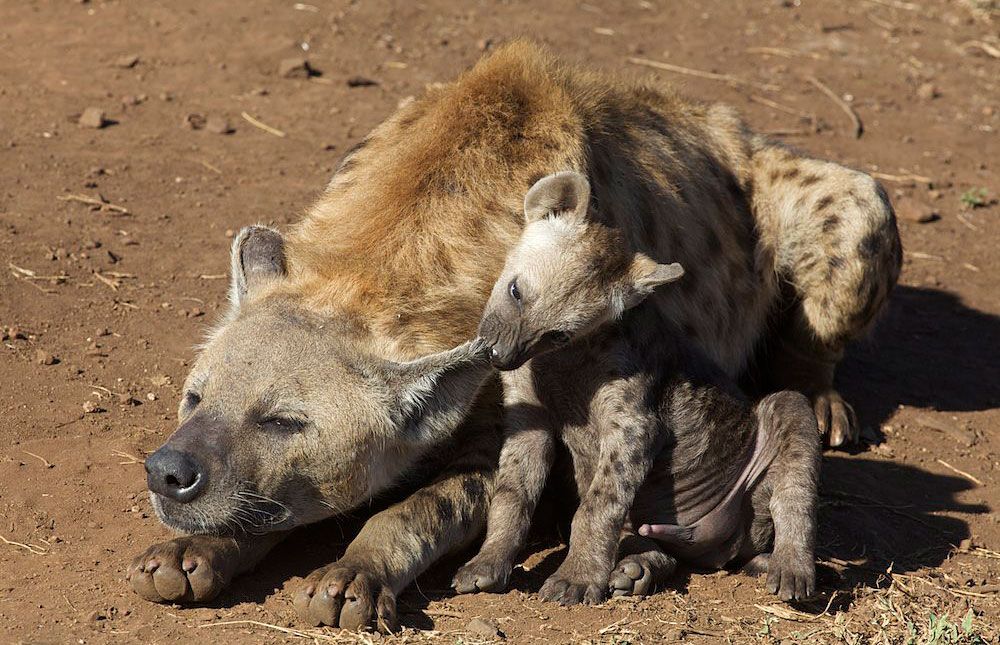Hyenas are often misunderstood animals, with their behaviors and biology shrouded in mystery. Despite their reputation for scavenging and their characteristic cackling laugh, hyenas are fascinating creatures with unique reproductive traits, particularly when it comes to how they give birth. This process is not only intriguing but also crucial to understanding hyena social dynamics, biology, and survival strategies. In this article, we will delve into the intricacies of how hyenas give birth, exploring their reproductive anatomy, the birthing process, and the challenges they face during reproduction.
1. Unique Reproductive Anatomy
The reproductive system of a hyena, especially that of the spotted hyena (Crocuta crocuta), is unlike most other mammals. Female hyenas possess a highly unusual anatomy that plays a critical role in their birth process. The female’s clitoris is elongated and resembles a penis, which can often lead to confusion about their gender. This structure, called a pseudopenis, is not only used for urination but also for mating.
Interestingly, the pseudopenis is integral to the hyena’s social structure. Dominant females, who are larger and more aggressive than the males, can use this organ to assert their power, even during mating. However, this unique anatomy creates challenges during birth.
2. The Birth Canal Challenge
The birthing process of hyenas is notorious for its difficulty. Due to the female’s pseudopenis, the birth canal is narrow and elongated, making it extremely difficult for hyena cubs to be born. In fact, about 60% of first-time mothers experience complications during labor, as the cubs must pass through the constricted birth canal. This often results in a lengthy and risky birth process.
Additionally, hyena cubs are born relatively large for their size, with their eyes open and fully furred. This is an evolutionary adaptation that helps the cubs survive in the wild, as they need to be mobile and alert shortly after birth to avoid predators.
3. The Birthing Process
When a female hyena is ready to give birth, she typically seeks a secluded location, away from the rest of the clan, though some births may take place in the dens or communal areas. Unlike many mammals that experience a prolonged labor, the birthing process for hyenas is relatively quick, typically lasting several hours. However, due to the narrow birth canal, the first stage of labor can be more challenging.
Hyena mothers often give birth to twins, although single births are also common. These cubs are usually born in a head-first position, but the struggle to pass through the birth canal can be strenuous. Despite the difficulty, the mother is generally highly capable and instinctively knows how to manage the birth. The cubs are born fully formed, and the mother immediately begins licking them to stimulate breathing and bonding.
4. Post-Birth Care and Survival
Once born, the cubs are placed in a den or a safe area where they will stay for the first few weeks of their lives. Hyena mothers are fiercely protective of their young and will often hide them in burrows or other sheltered locations to keep them safe from predators like lions or other rival hyenas.
Cubs will nurse from their mother for several months. Hyena milk is rich in nutrients and helps the young hyenas grow rapidly. However, because the social structure of hyena clans is matriarchal, there is often fierce competition among cubs, even from different litters, for access to their mother’s milk. This competitive environment can make early life challenging for young hyenas, and only the strongest survive.
5. Social Structure and Its Impact on Birth
In the highly structured social system of hyenas, the position of a female within the clan hierarchy plays a significant role in the birthing process. Dominant females have preferential access to resources, including food, shelter, and the attention of the clan’s males. This gives them an advantage when it comes to raising their cubs. Meanwhile, subordinate females often face greater challenges, including harassment from other clan members, which can affect their health and the survival chances of their offspring.
The survival of a hyena cub is not just a matter of being born—it also depends on the dynamics of the clan. Cubs born to lower-ranking females may struggle to thrive, as they face greater competition and less access to resources. However, dominant cubs from higher-ranking mothers are more likely to receive better care and have a higher chance of survival into adulthood.
6. The Role of Males in Birth and Parenting
Unlike many other mammals, male hyenas do not play an active role in the birthing process or in raising the young. While they may participate in mating, the responsibility of birth and cub-rearing primarily falls to the females. Male hyenas do, however, play a critical role in the clan’s social structure. Their position within the clan can impact the survival of their offspring indirectly by determining the overall dynamics of the group.

Conclusion
The process of giving birth for hyenas is challenging and unique, primarily due to their unusual reproductive anatomy and the difficulty posed by their narrow birth canal. However, despite these challenges, hyenas have evolved to give birth to strong, capable cubs that are equipped to survive in the wild. The complexity of their social structure and the matriarchal nature of their clans further influence the survival and success of their offspring. By understanding how hyenas give birth, we gain a deeper appreciation for the resilience and adaptability of these often-misunderstood creatures.



